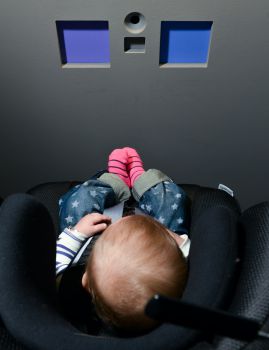Baby blues...and greens, reds and yellows
By: Jacqui Bealing
Last updated: Friday, 15 February 2019

By the time we are four months old we can distinguish between colours – even before we have the language to describe them.
Recent ground-breaking University of Sussex research found that babies were able to categorise shades of red, blue, green, yellow and purple.
The study, which used eye-tracking technology to test the direction and interest of an infant’s gaze, suggests that our innate biology accounts for our ability to label colours. We know that specialised cells in our eyes are sensitive to different wavelengths of light, which our brains then interpret as distinct colours.
But as humans, we live in a variety of landscapes – from monotone deserts to vibrant rainforests. So how does our colour perception relate to our individual surroundings?
This question is now being addressed by researchers in the Sussex BabyLab, a research group at the university that specialises in how babies and toddlers understand colour. Their new project, COLOURMIND, aims to find the differences and similarities between how babies and adults see their world.
BabyLab psychologist Dr Jenny Bosten explains: “As adults, our visual systems show a preference for colours and patterns that appear in our natural scenes – the ones with which we’re familiar.
“But an urban environment colour palette may be very different to a more rural environment. We are looking to find out if and how babies learn to represent the palettes of colours in their own natural scenes.”
For the babies this means a short test (anything from five minutes to until they get bored), during which they are shown images of objects or scenes familiar to their environment (such as trees and sky), but with “unnatural” colours.
“Babies make great scientists,” says Jenny. “They’re eager to learn and hard to fool. And with developments in technology we are now able to capture and interpret information in ways that wasn’t possible before.”
The research also investigates adult colour vision, studying the malleability of our perception by using virtual reality headsets to feed participants an altered version of colour reality.
While the research is already underway at the university’s Falmer campus, the five-year project will also investigate the effect on perception of living in radically different environments. Later this year the researchers will take their experiment to Ecuadorean rainforest communities.
“We have several different streams of research,” says Jenny. “We are looking to see if people’s colour perception changes according to the seasons, and according to the colours that are in their environments. For example, in the Arctic Circle there’s evidence that people’s colour perception varies according to the month of their birth. It could be dependent on the light they were exposed to in the early months of their lives.”
She adds: “The findings will not only help us to understand more about how we perceive colour, but can help to explain how the brain processes other perceptual information, such as speech patterns and memories.”

